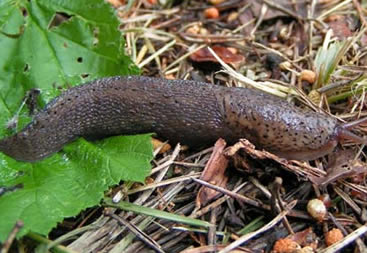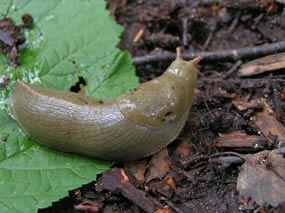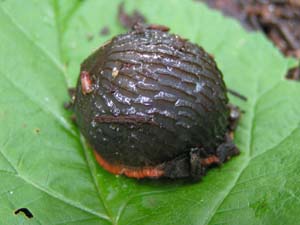

NATURE NOTES

European Great Grey Slug, photo by Hugh Griffith
[Editor's Note: a.k.a. Giant Garden Slug, Limax maximus]
The Good, the Bad and the Ugly
by
Dry hot weather does not go over well with creatures that thrive in the dark and damp. Thus the terrestrial gastropods of Richmond (slugs and snails) raced around, sort of, in celebration of this past Saturday's generous rainfall. Who are these animals and what do they do?
Many of our commonest slugs, snails and other soil-dwelling invertebrates (worms, ants, and so on) are originally from other continents. The soils of the world are the true melting pot of the planet, because the eggs and other life stages of many small life forms have been transported inadvertently by humans far and wide for generations. And as is often the case, the imported species are problematical to the ecology of a region, by out-competing or preying upon natives that lack the evolutionary leg up to cope.
Of our three largest slugs, only the Banana Slug is native. It is the second largest species in the world and can grow to more than 20 cm. If there is a creature that truly symbolizes the great rainy Northwest, I suggest it is the Banana Slug. It is a good slug, almost never found in gardens or crops. In natural habitats it acts as Nature's garbage collector and recycler, consuming and further breaking down dead and decaying matter.

Banana Slug, photo by Hugh Griffith
[Eidtor's Note: a.k.a. Pacific Bananslug, Ariolimax columbianus]
The conspicuous hole on the side of the slug is called the pneumostome. Air passes through here to the gill, a reminder that slugs have an aquatic history and are brave pioneers of the terrestrial world. There is only one pneumostome, on the right side, harking back to the shell-bearing ancestry of all slugs. Snails are not bilaterally symmetrical (left side = right side), thus neither are their slug descendants.
The Great Grey Slug of Europe is a voracious garden pest, and the fastest of our slugs. It is able to crawl four times faster than the Banana Slug, perhaps 6 inches in a minute. Not only will it devour many species of plant, this slug is also a predator who will stalk and eat other slugs. I have not witnessed this, but have seen footage of cheetahs chasing gazelles. It is probably similar, but much slower.

Eruopean Black Slug, photo by Hugh Griffith
[Editor's Note: a.k.a. Chocolate Arion, Arion rufus]
The third large species is the European Black Slug. It can also be grey or brown, has a furrowed back, and often has a rusty orange edge to its foot. It is another import, known to attack crops and garden plants. If you encounter one and are feeling bold, poke it gently. It will tighten into a ball and start wobbling side to side, very slowly. It is one of nature's most inexplicable and strangely mesmerizing performances, worth watching if you have a lot of time to kill.
One thing all slugs have in common is slime. They use it for protection and as a slick yet sticky surface that makes crawling that much easier - and speedier! At a molecular level, slime turns out to be a highly organized material that can absorb up to 100 times its original volume in water. This property is readily apparent should you ever make the mistake of trying to rinse slug slime from your fingers. Slime begets more slime. Simply wait for it to dry and then roll it off, as you would rubber cement.
Slugs cannot hurt you, but the bad ones will eat your strawberries. In which case, get yourself a duck.
Hugh Griffith is a BC zoologist and science writer.
Please cite these pages as:
Author, date, page title. In: Klinkenberg, Brian. (Editor) 2021. E-Fauna BC: Electronic Atlas of the Fauna of British Columbia [www.efauna.bc.ca]. Lab for Advanced Spatial Analysis, Department of Geography, University of British Columbia, Vancouver. [Date Accessed]
© Copyright 2021 E-Fauna BC.